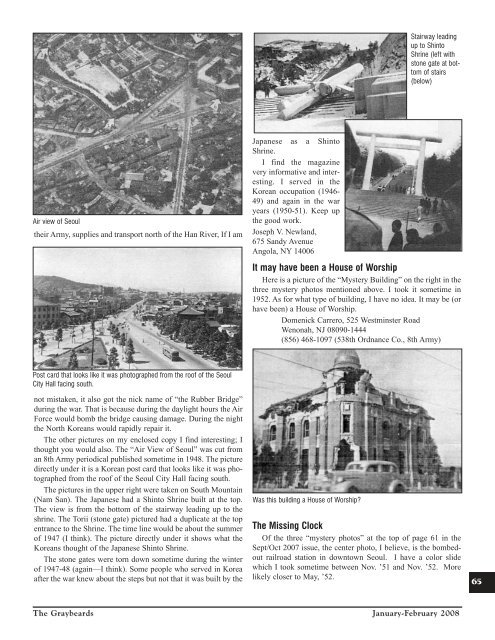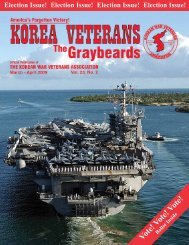Jan/Feb 2008 - KWVA - Korean War Veterans Association
Jan/Feb 2008 - KWVA - Korean War Veterans Association
Jan/Feb 2008 - KWVA - Korean War Veterans Association
Create successful ePaper yourself
Turn your PDF publications into a flip-book with our unique Google optimized e-Paper software.
Stairway leading<br />
up to Shinto<br />
Shrine (left with<br />
stone gate at bottom<br />
of stairs<br />
(below)<br />
Air view of Seoul<br />
their Army, supplies and transport north of the Han River, If I am<br />
Japanese as a Shinto<br />
Shrine.<br />
I find the magazine<br />
very informative and interesting.<br />
I served in the<br />
<strong>Korean</strong> occupation (1946-<br />
49) and again in the war<br />
years (1950-51). Keep up<br />
the good work.<br />
Joseph V. Newland,<br />
675 Sandy Avenue<br />
Angola, NY 14006<br />
It may have been a House of Worship<br />
Here is a picture of the “Mystery Building” on the right in the<br />
three mystery photos mentioned above. I took it sometime in<br />
1952. As for what type of building, I have no idea. It may be (or<br />
have been) a House of Worship.<br />
Domenick Carrero, 525 Westminster Road<br />
Wenonah, NJ 08090-1444<br />
(856) 468-1097 (538th Ordnance Co., 8th Army)<br />
Post card that looks like it was photographed from the roof of the Seoul<br />
City Hall facing south.<br />
not mistaken, it also got the nick name of “the Rubber Bridge”<br />
during the war. That is because during the daylight hours the Air<br />
Force would bomb the bridge causing damage. During the night<br />
the North <strong>Korean</strong>s would rapidly repair it.<br />
The other pictures on my enclosed copy I find interesting; I<br />
thought you would also. The “Air View of Seoul” was cut from<br />
an 8th Army periodical published sometime in 1948. The picture<br />
directly under it is a <strong>Korean</strong> post card that looks like it was photographed<br />
from the roof of the Seoul City Hall facing south.<br />
The pictures in the upper right were taken on South Mountain<br />
(Nam San). The Japanese had a Shinto Shrine built at the top.<br />
The view is from the bottom of the stairway leading up to the<br />
shrine. The Torii (stone gate) pictured had a duplicate at the top<br />
entrance to the Shrine. The time line would be about the summer<br />
of 1947 (I think). The picture directly under it shows what the<br />
<strong>Korean</strong>s thought of the Japanese Shinto Shrine.<br />
The stone gates were torn down sometime during the winter<br />
of 1947-48 (again—I think). Some people who served in Korea<br />
after the war knew about the steps but not that it was built by the<br />
Was this building a House of Worship?<br />
The Missing Clock<br />
Of the three “mystery photos” at the top of page 61 in the<br />
Sept/Oct 2007 issue, the center photo, I believe, is the bombedout<br />
railroad station in downtown Seoul. I have a color slide<br />
which I took sometime between Nov. ’51 and Nov. ’52. More<br />
likely closer to May, ’52.<br />
65<br />
The Graybeards <strong>Jan</strong>uary-<strong>Feb</strong>ruary <strong>2008</strong>
















